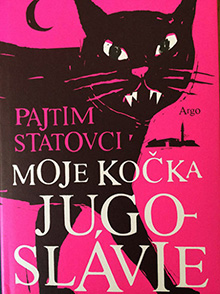 My Cat Yugoslavia
My Cat Yugoslavia
by Patím Statovsi
Translated by David Hackston
Published by Pantheon
Published April 18, 2017
Fiction (foreign)
272 pgs. • Find on Amazon.com • WorldCat
Reviewed by Stephen O. Murray
October 2, 2017
Published in Finnish when he was 24 (in 2014), Albanian Kosovo-born Patím Statovsi’s novel My Cat Yugoslavia (English translation by David Hackston published in 2017) has IMO been overhyped.
It is certainly a timely exposition of some of the indignities and outright assaults refugees experience. Stavosi went to Finland when he was two and I presume could speak Finnish by the time he started school. His gay protagonist, Bekim, went to Finland with his family at an older (unspecified) age with a younger brother, three younger sisters, and their parents. The father, who beats his wife and children relentlessly, becomes more Muslim in Finland and returns to Kosovo when he can. None of the others wants to return to what has become a strange land to them. The mother is very relieved not to be serving her husband’s demands (most of them unspoken); the children are culturally Finnish, despite their Slavic appearances.
The book beings with Bekim making an online connection with a man he finds very attractive but whom he does not permit to stay the night. Later in the novel there is a trick with a married man on a visit to Kosovo (Prishtina) and eventually a very devoted, older Finnish lover (whose love Bekim finds stifling, though he clearly wants to live to serve the pleasures of his lover).
I don’t think My Cat Yugoslavia is a “gay novel,” even with a gay protagonist. More of Bekim’s half of the book concerns his relationships with a very spoiled cat (who loathes gays and detests refugees) whom Bekim meets in a gay disco and a stolid boa constrictor (who loathes the terrarium Bekim bought for him and spends most of his time under a sofa in Bekim’s apartment) Bekim buys in a pet store, though as a child he was plagued by nightmares of snakes. The cat is much less entertaining than Behemoth in Mikhail Bulgakov’s The Master and Margarita,[1]Statovci is on record as a long-time admirer of The Master and Margarita: https://www.pushkinpress.com/patjim-statovci-5-books-that-made-me-a-writer/ alas. I can’t think of a snake being a major character in any other novel. Both the snake and the cat hiss, sometimes at each other.
 The cat is as intolerant and expectant of being served as Bajram, the affluent and educated Kosovo Albanian who has his family arrange a marriage in 1980 (the day after Tito died, though this news is kept from the bride) with a pretty and demure lass, Emine, who is the narrator of alternating chapters (and who is Bekim’s mother). Her story is more conventional and far more awful than Bekim’s, though he is the one who undergoes an exorcism by a Turkish imam in Finland. Things got worse in Kosovo after they left in 1993, though their apartment had been broken into and ransacked in the reign of Serbian terror against Albanians that was escalating.
The cat is as intolerant and expectant of being served as Bajram, the affluent and educated Kosovo Albanian who has his family arrange a marriage in 1980 (the day after Tito died, though this news is kept from the bride) with a pretty and demure lass, Emine, who is the narrator of alternating chapters (and who is Bekim’s mother). Her story is more conventional and far more awful than Bekim’s, though he is the one who undergoes an exorcism by a Turkish imam in Finland. Things got worse in Kosovo after they left in 1993, though their apartment had been broken into and ransacked in the reign of Serbian terror against Albanians that was escalating.
Romantic fantasies about marriage to a handsome man began to unravel even before the wedding ceremony. Bajram is not only very authoritarian but has a hair-trigger temper, lashing out (and just lashing) his wife and children. And his part-time job in Finland is lost because of his proselytizing for Islam. (He becomes a robber and a smuggler.)
Bekim has few romantic fantasies (fewer than his eventual Finnish lover does). Both mother and son clean compulsively and are skittish about going out into the society that has taken them in (without the homogeneous and xenophobic populace accepting aliens the government has accepted). Bekim staying in the apartment parallels his snake staying under the sofa (the cat exercises his freedom to leave).
I find both narrators convincing characters. The alternation of narrators doesn’t seem to me especially effective, but I read the chapters in the order Statovci supplied them rather than reading all Emine’s first, then Bekim’s.
(I find it puzzling that refugees could visit their homeland, quite apart from it being a war zone through the 1990s. Finnish asylum laws must differ from US ones, I guess.)
©2017, Stephen O. Murray

